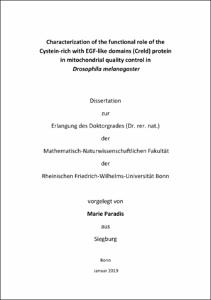Paradis, Marie: Characterization of the functional role of the Cystein-rich with EGF-like domains (Creld) protein in mitochondrial quality control in Drosophila melanogaster. - Bonn, 2019. - Dissertation, Rheinische Friedrich-Wilhelms-Universität Bonn.
Online-Ausgabe in bonndoc: https://nbn-resolving.org/urn:nbn:de:hbz:5-55306
Online-Ausgabe in bonndoc: https://nbn-resolving.org/urn:nbn:de:hbz:5-55306
@phdthesis{handle:20.500.11811/8050,
urn: https://nbn-resolving.org/urn:nbn:de:hbz:5-55306,
author = {{Marie Paradis}},
title = {Characterization of the functional role of the Cystein-rich with EGF-like domains (Creld) protein in mitochondrial quality control in Drosophila melanogaster},
school = {Rheinische Friedrich-Wilhelms-Universität Bonn},
year = 2019,
month = aug,
note = {Cystein-rich with EGF-like domains (Creld) proteins belong to a protein family conserved between species. The mammalian genome contains two Creld genes. Unraveling the function of mammalian Creld proteins has been tried before. It is thought that Creld1 is involved in heart development during embryogenesis and Creld2 is believed to be involved in ER stress response. The genome of Drosophila contains only one Creld gene, which simplifies the analysis of Creld function. Therefore, a Creld mutant was generated and in this project the phenotypes were analyzed in order to unravel the main function of the Creld protein in Drosophila.
Creld mutant flies suffer from an overall energy deficit, which could be proven by determining the phosphorylation status of the overall energy sensor AMPK. The energy deficits are accompanied with an increased number of apoptotic cells in the brain and severe locomotor deficiencies. Additionally, the heart function of Creld mutant flies is disturbed.
Mitochondria are known as the power house of the cell, as they account for the major cellular ATP production via oxidative phosphorylation. By analyzing mitochondrial abundance, morphology and function in Creld mutants, it could be shown that the overall function of mitochondria is reduced whereas mitochondrial mass and abundance is increased. The morphology of mitochondria was assessed and revealed an elongated form compared to wild type tissue. Together, these results could demonstrate a shift of mitochondrial dynamics towards increased fusion and decreased fission.
The resulting dysfunction of mitochondria caused a disturbance in the overall cellular metabolism including altered lipid homeostasis. Taken together, this thesis could identify a novel role for the Creld protein in Drosophila by regulating mitochondrial maintenance and thereby controlling cellular energy and lipid metabolism.},
url = {https://hdl.handle.net/20.500.11811/8050}
}
urn: https://nbn-resolving.org/urn:nbn:de:hbz:5-55306,
author = {{Marie Paradis}},
title = {Characterization of the functional role of the Cystein-rich with EGF-like domains (Creld) protein in mitochondrial quality control in Drosophila melanogaster},
school = {Rheinische Friedrich-Wilhelms-Universität Bonn},
year = 2019,
month = aug,
note = {Cystein-rich with EGF-like domains (Creld) proteins belong to a protein family conserved between species. The mammalian genome contains two Creld genes. Unraveling the function of mammalian Creld proteins has been tried before. It is thought that Creld1 is involved in heart development during embryogenesis and Creld2 is believed to be involved in ER stress response. The genome of Drosophila contains only one Creld gene, which simplifies the analysis of Creld function. Therefore, a Creld mutant was generated and in this project the phenotypes were analyzed in order to unravel the main function of the Creld protein in Drosophila.
Creld mutant flies suffer from an overall energy deficit, which could be proven by determining the phosphorylation status of the overall energy sensor AMPK. The energy deficits are accompanied with an increased number of apoptotic cells in the brain and severe locomotor deficiencies. Additionally, the heart function of Creld mutant flies is disturbed.
Mitochondria are known as the power house of the cell, as they account for the major cellular ATP production via oxidative phosphorylation. By analyzing mitochondrial abundance, morphology and function in Creld mutants, it could be shown that the overall function of mitochondria is reduced whereas mitochondrial mass and abundance is increased. The morphology of mitochondria was assessed and revealed an elongated form compared to wild type tissue. Together, these results could demonstrate a shift of mitochondrial dynamics towards increased fusion and decreased fission.
The resulting dysfunction of mitochondria caused a disturbance in the overall cellular metabolism including altered lipid homeostasis. Taken together, this thesis could identify a novel role for the Creld protein in Drosophila by regulating mitochondrial maintenance and thereby controlling cellular energy and lipid metabolism.},
url = {https://hdl.handle.net/20.500.11811/8050}
}






